Filling out the Ohio Divorce Settlement Agreement form can be a complex process. Many individuals make mistakes that can lead to delays or complications in their divorce proceedings. Understanding these common errors can help ensure a smoother experience.
One frequent mistake is not providing complete information. When individuals leave sections blank or provide vague responses, it can create confusion. Every detail matters, including names, addresses, and specific terms of the agreement. Incomplete forms may be returned, causing unnecessary delays.
Another common error involves failing to accurately calculate financial obligations. This includes child support, spousal support, and division of assets. Miscalculating these figures can lead to disputes later on. It is crucial to double-check all financial information and ensure that it reflects the true intentions of both parties.
People often overlook the importance of legal descriptions for property. When describing real estate, it is essential to use accurate legal descriptions rather than just addresses. This mistake can complicate property division and may lead to future legal issues.
Additionally, some individuals neglect to include all assets and debts. Omitting even a single asset can lead to significant problems. Both parties should compile a comprehensive list of all marital property and debts to avoid disputes down the line.
Another mistake is not considering tax implications. Divorce can have significant tax consequences, and failing to account for these can affect financial stability post-divorce. Consulting a tax professional before finalizing the agreement can help mitigate these issues.
People sometimes forget to review the agreement thoroughly before submission. Rushing through the process can lead to overlooked errors or misunderstandings. Taking the time to review the document ensures that both parties are in agreement with the terms laid out.
Furthermore, not having a witness or notary present when signing the agreement can invalidate the document. It is essential to follow Ohio's legal requirements for signatures to ensure that the agreement is enforceable.
Lastly, individuals may not consider future changes in circumstances. Life is unpredictable, and what works at the time of the divorce may not be suitable later. Including provisions for modifications can help both parties adapt to future changes without further legal disputes.
